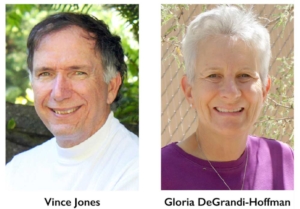For growers seeking the best way to prevent apple trees from setting too much fruit, a new tool aims to help them by predicting pollination.
A model that tracks honeybee behavior in orchards could help growers manage pollination in real time and prevent expensive thinning bills later, said Vince Jones, entomology professor at Washington State University and director of the Decision Aid System (DAS) that provides pest and disease models to growers.
The model uses data on weather conditions and crop phenology to predict and estimate honeybee foraging and the fruit set that follows.
 “Fruit set is driven by pollination, so the idea is that these models will have the growers decide how much thinning they have to do and how long they have to have the honeybees out there,” Jones said. “Essentially, it’s a way of reducing that variability — especially with the changing weather profiles we are having in the spring.”
“Fruit set is driven by pollination, so the idea is that these models will have the growers decide how much thinning they have to do and how long they have to have the honeybees out there,” Jones said. “Essentially, it’s a way of reducing that variability — especially with the changing weather profiles we are having in the spring.”
The new model is expected to be rolled out to Washington growers in phases over the next few years. It’s built based on a model of honeybee foraging and bloom phenology developed years ago by Gloria DeGrandi-Hoffman, the research leader at the USDA-ARS Carl Hayden Bee Research Center in Tucson, Arizona.
“I always thought this model needed to be used by Washington state apple growers, so I thought it was a great opportunity,” DeGrandi-Hoffman said.
Mainframe to mobile
As it turns out, DeGrandi-Hoffman had been waiting for someone to call her about her model for decades. She originally developed the foraging effectiveness and fruit set model as a graduate student at Michigan State University in the 1980s.
Built on a mainframe computer and run using weather data entered with punch cards, DeGrandi-Hoffman successfully predicted fruit set in Red Delicious and Golden Delicious orchards.
After graduating, she brought the model with her to the USDA Bee Lab in Tucson, where they adapted it to run on a PC but then her career took her onto other projects.
“When Vince called me, I said I’ve been waiting more than 20 years for you,” she said with a laugh. “I’m just really thrilled to be working on this and to have the opportunity to come to Washington state to learn about how people are growing apples there.”
The underlying model hasn’t changed. Honeybee foraging behavior is still driven by bloom density and weather factors: temperature, wind speed, precipitation and solar radiation. And the pace of the bloom — how many flowers are present and at what stage — is controlled by temperature, too, so it can be predicted by the weather-based model as well.
“Once we know how many open blossoms there are, we can predict how much foraging is going on, how much pollen is moving around and, therefore, how much fruit set is there,” DeGrandi-Hoffman said.
But orchards have changed. New cultivars and new high-density systems have changed the landscape for bees as well as for growers. So the model needs to change too — and to understand how, DeGrandi-Hoffman visited Washington orchards with Jones last year.
“Boy, it’s really different than the way we did it in Michigan in the ’80s,” DeGrandi-Hoffman said.
In the new version, growers will have to enter orchard specific information, such as how long their trellis is, how their pollinizers are spaced and, on average, the density of their bloom clusters. Field work to track bloom phenology for newer varieties including Cripps Pink, Gala and Honeycrisp was done during recent growing seasons.
“Even if you have a lot of bees foraging, if you don’t have bloom of compatible cultivars, you aren’t going to get fruit set even though you have lots of bees flying,” DeGrandi-Hoffman said.
Rollout
Jones said that WSU plans to release the model in two pieces, one that just rates honeybees’ foraging efficiency so that growers can decide if they need to keep bees in the orchard longer, for example, and then the fruit set model that incorporates the foraging efficiency.
The honeybee foraging model should be available to beta users of DAS this season, Jones said. Beta users are a small group of frequent DAS users who offer feedback on new models before those models are rolled out to the entire network. All users should have access to the foraging model in 2018.
There are still about two years left of work to incorporate all the information on new cultivar phenology into the fruit-set model, Jones said.
Then, the researchers also want to see if a cherry bloom model developed at Oregon State University could be incorporated to predict honeybee foraging on cherries.
The project is funded with a $220,000 grant from the Washington Tree Fruit Research Commission. Eventually, the model could be implemented in other regions as well, as long as programmers adjust it to work with the weather station data available to those growers. •
– by Kate Prengaman






Leave A Comment